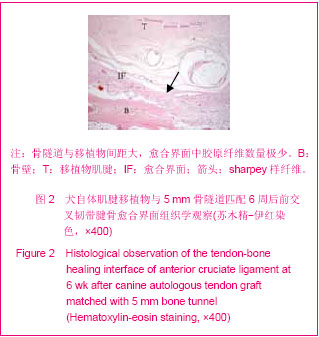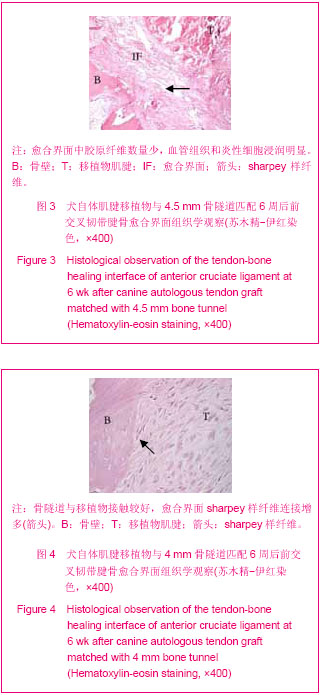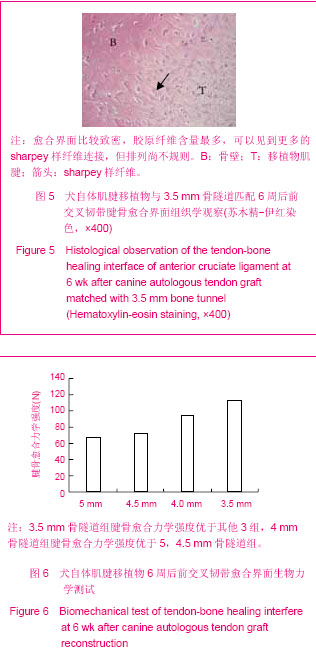| [1] 刘东波,沙鹏.运动性膝关节交叉韧带损伤:重建生物材料的选择[J].中国组织工程研究,2012,16(38):7169-7176.[2] Fanelli GC, Edson CJ. Surgical treatment of combined PCL-ACL medial and lateral side injuries (global laxity): surgical technique and 2- to 18-year results. J Knee Surg. 2012;25(4):307-316. [3] Scanlan SF, Lai J, Donahue JP, et al. Variations in the three-dimensional location and orientation of the ACL in healthy subjects relative to patients after transtibial ACL reconstruction. J Orthop Res. 2012;30(6):910-918. [4] Zantop T, Ferretti M, Bell KM, et al. Effect of tunnel-graft length on the biomechanics of anterior cruciate ligament-reconstructed knees: intra-articular study in a goat model. Am J Sports Med. 2008;36(11):2158-2166.[5] Chudik S, Beasley L, Potter H, et al. The influence of femoral technique for graft placement on anterior cruciate ligament reconstruction using a skeletally immature canine model with a rapidly growing physis. Arthroscopy. 2007;23(12):1309-1319. [6] 李敏,王丽霞,张瑞存.异体肌腱及跟腱移植后移植物的免疫学特点[J].中国组织工程研究与临床康复,2012,16(5):915-918.[7] 刘心,冯华,张辉.同种异体跟腱移植物重建内侧副韧带浅层结构治疗膝关节外翻不稳定的临床研究[J].中国运动医学杂志,2012, 31(11):949-956. [8] Sun L, Hou C, Wu B, et al. Effect of muscle preserved on tendon graft on intra-articular healing in anterior cruciate ligament reconstruction. Knee Surg Sports Traumatol Arthrosc. 2012 Aug 29. [9] Kondo E, Yasuda K, Katsura T,et al. Biomechanical and histological evaluations of the doubled semitendinosus tendon autograft after anterior cruciate ligament reconstruction in sheep. Am J Sports Med. 2012;40(2):315-324.[10] Ahn JH, Jeong HJ, Ko CS, et al. Three-Dimensional Reconstruction Computed Tomography Evaluation of Tunnel Location during Single-Bundle Anterior Cruciate Ligament Reconstruction: A Comparison of Transtibial and 2-Incision Tibial Tunnel-Independent Techniques. Clin Orthop Surg. 2013;5(1):26-35. [11] Beynnon BD, Johnson RJ, Fleming BC. The science of anterior cruciate ligament rehabilitation. Clin Orthop Relat Res. 2002;(402):9-20. [12] Cabaud HE, Feagin JA, Rodkey WG. Acute anterior cruciate ligament injury and augmented repair. Experimental studies. Am J Sports Med. 1980;8(6):395-401.[13] Petersen W, Tillmann B. Anatomy and function of the anterior cruciate ligament. Orthopade. 2002;31(8):710-718.[14] Mainil-Varlet P, Schiavinato A, Ganster MM. Efficacy Evaluation of a New Hyaluronan Derivative HYADD® 4-G to Maintain Cartilage Integrity in a Rabbit Model of Osteoarthritis. Cartilage. 2013;4(1):28-41.[15] Carey T, Oliver D, Pniewski J, et al. Anterior cruciate ligament augmentation for rotational instability following primary reconstruction with an accelerated physical therapy protocol.J Surg Orthop Adv. 2013;22(1):59-65.[16] Sutton KM, Bullock JM. Anterior cruciate ligament rupture: differences between males and females.J Am Acad Orthop Surg. 2013;21(1):41-50. [17] Kurosaka M, Yoshiya S, Andrish J. A biomechanical comparison of different surgical techniques of grart fixation in anterior cruciate ligament reconstruction. A J Sports Med. 1987; 15(3):225-229 .[18] Lambert K. Vascularized patellar tendon graft with rigid internal fixation for anterior cruciate ligament insufficiency. Clin Orthop.1983;172:85-89.[19] Hoher J, Moller HD, Fu FH. Bone tunnel enlargement after anterior cruciate ligament reconsruction: fact or fiction? Knee Surg Sports Traumatol Arthrosc. 1998;6(4):231-240.[20] Messner K. Postnatal development of the cruciate ligament insertions in the rat knee: morphological evalution and immunohistochemical study of collagens types Ⅰ and Ⅱ. Acta Anat (Basel). 1997;160(4):261-268.[21] Ye S, Dongyang C, Zhihong X, et al.The incidence of deep venous thrombosis after arthroscopically assisted anterior cruciate ligament reconstruction. Arthroscopy.2013;29(4): 742-747.[22] Dwyer T, Whelan D. Anatomical considerations in multiligament knee injury and surgery.J Knee Surg. 2012;25(4):263-274. [23] Gao J, Rasanen T, Persliden J, et al. The morphology of ligament insertions after failure at low strain velocity. An evaluation of ligament enthuses in the rabbit knee. J Anat. 1996;189(Pt 1):127-133.[24] Winiarski S, Czamara A. Evaluation of gait kinematics and symmetry during the first two stages of physiotherapy after anterior cruciate ligament reconstruction.Acta Bioeng Biomech. 2012;14(2):91-100.[25] Carpenter JE, Hankenson KD. Animal models of tendon and ligament injuries for tissue engineering applications. Biomaterials. 2004;25(9):1715-1722.[26] Ntoulia A, Papadopoulou F, Ristanis S,et al.Revascularization process of the bone--patellar tendon--bone autograft evaluated by contrast-enhanced magnetic resonance imaging 6 and 12 months after anterior cruciate ligament reconstruction.Am J Sports Med. 2011;39(7):1478-1486. [27] Vogrin M, Rupreht M, Dinevski D, et al. Effects of a platelet gel on early graft revascularization after anterior cruciate ligament reconstruction: a prospective, randomized, double-blind, clinical trial. Eur Surg Res. 2010;45(2):77-85.[28] Weiler A, Hoffmann RFG, Bail HJ, et al. Tendon healing in a bone tunnel. Part II: histologic Analysis after biodegradable interference fit fixation in a model of anterior cruciate ligament reconstruction in sheep. Arthroscopy. 2002;18(2): 124-135.[29] Muller B, Bowman KF Jr, Bedi A. CL graft healing and biologics.Clin Sports Med. 2013;32(1):93-109. [30] Kondo E, Yasuda K, Katsura T, et al. Biomechanical and histological evaluations of the doubled semitendinosus tendon autograft after anterior cruciate ligament reconstruction in sheep.Am J Sports Med. 2012;40(2): 315-324. [31] Buelow JU, Siebold R, Ellermann A, et al. A prospective evaluation of tunnel enlargement in anterior cruciate ligament reconstruction with hamstrings: extracortical versus anatomical fixation. Knee Surg Sports Traumatol Arthrose. 2002;10(2):80-85.[32] Parker MG.Biomechanical and histological concepts in the rehabilitation of patients with anterior cruciate ligament reconstructions. J Orthop Sports Phys Ther. 1994;20(1): 44-50.[33] Jorgensen U, Thomsen HS. Behavior of the graft within the bone tunnels following anterior cruciate ligament reconstruction,studied by cinematic magnetic resonance imaging. Knee Surg Sports Traumatol Arthrose.2000;8(1): 32-35.[34] Segawa H, Omori G, Tomita S,et al.Bone tunnel enlargement after anterior cruciate ligament reconstruction using hamstring tendons. Knee Surg Sports Traumatol Arthrose.2001;9(4): 206-210.[35] Yamakado K, Kitaoka K, Yamada H, et al. Periosteal augmentation of a tendon graft improves tendon healing in the bone tunnel. Clin Orthop. 2004;419:223-231.[36] Rodeo SA, Arnoczky SP, Torzilli PA, et al. Tendon-healing in a bone tunnel: a biomechanical and histological study in the dog. J Bone J Surg(Am).1993;75(2):1795-1803.[37] Darabos N, Hundric-Haspl Z, Haspl M,et al. Correlation between synovial fluid and serum IL-1beta levels after ACL surgery-preliminary report.Int Orthop. 2009;33(2):413-4388. [38] Roy S, Fernhout M, Stanley R, et al.Tibial interference screw fixation in anterior cruciate ligament reconstruction with and without autograft bone augmentation.Arthroscopy. 2010; 26(7):949-956. [39] Tien YC, Chih HW, Cheng YM, et al. The influence of the gap size on the interfacial union between the bone and the tendon. Kaohsiung J Med Sci. 1999;15(10):581-588 |



.jpg)